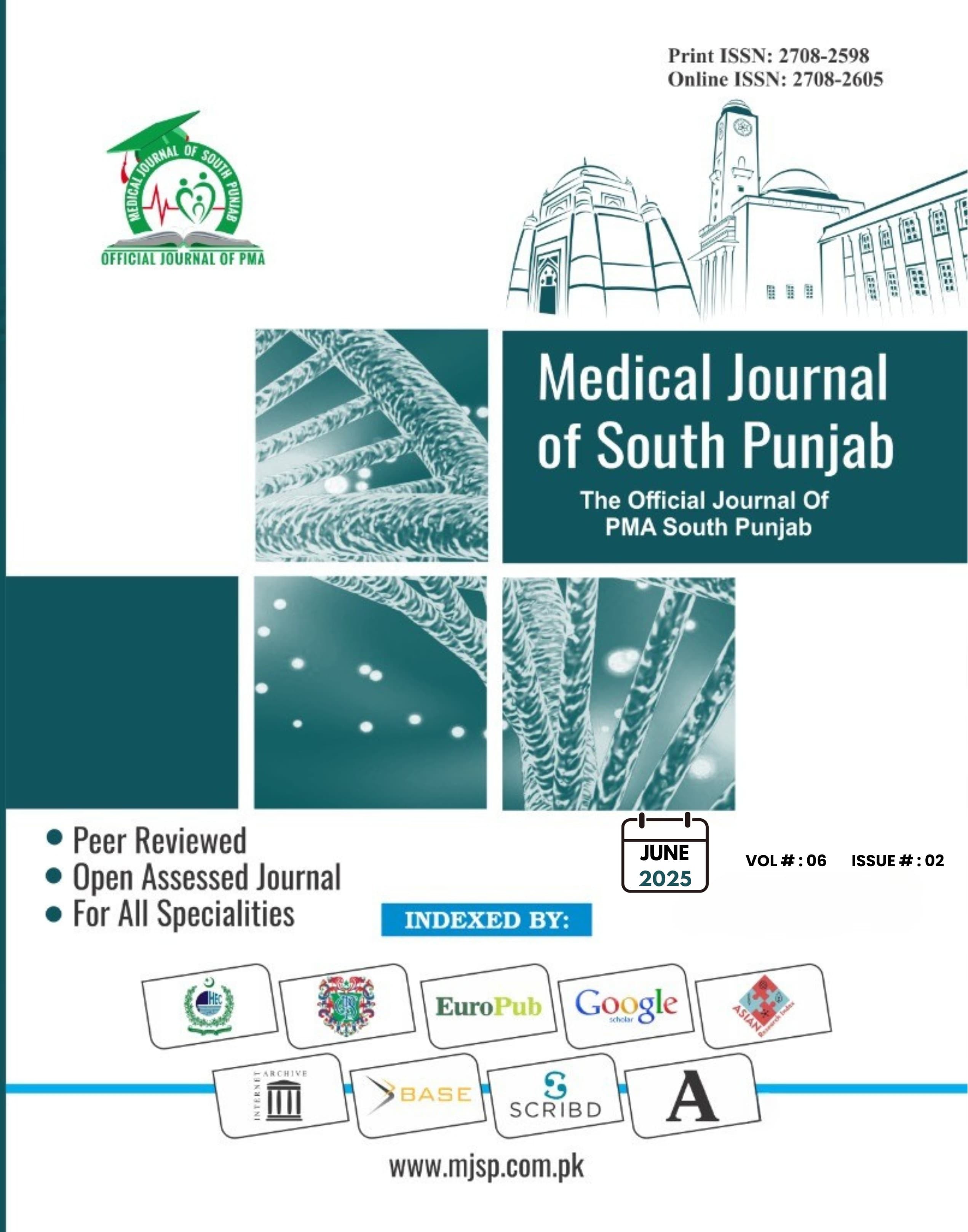Comparison of computed tomography bone mineral density (BMD) with vitamin D levels
DOI:
https://doi.org/10.61581/mjsp.v6i02.324Keywords:
Bone Mineral Density, Bone Density, Bone Pains, Vitamin D, Osteoporosis, OsteopeniaAbstract
Objective: To compare the CT-bone mineral density (CT-BMD) with the vitamin D levels
Methodology: A cross-sectional study was conducted from April 1st, 2023, to March 31st, 2024, at the Radiology Department, CMH Bahawalpur. One hundred patients presenting with bone pain who were referred to the radiology department for CT-BMD were included in the study. After baseline characteristics, vitamin D levels (25-OHD) were measured and categorized as ?30 ng/mL as normal, 21-29 ng/mL insufficient, and ?20 ng/mL as deficient. BMD was measured using computed tomography of the lumbar spine at L1-L4. A T-score of > -1 was considered normal, between -1 and -2.5 as osteopenia and < -2.5 as osteoporosis.
Results: The mean age of the patients was 55.05±10.54 years, comprised of 31% males. The mean BMI was 26.17±3.20. The mean vitamin D level among patients was 22.22±10.35, with 59.0% as deficient, while the mean CT BMD was -1.85±1.14, with 29.0% with osteoporosis. However, about 11% of patients with osteoporosis had normal vitamin D levels. Both variables had a significant association when vitamin D was compared with CT-BMD (p<0.001). When data was stratified, normal BMI patients, overweight, and rural residents had no significant effect on the association.
Conclusion: Our study concluded that CT BMD-reported osteoporosis is significantly associated with deficient vitamin D levels.
Downloads
References
1. Marozik P, Rudenka A, Kobets K, Rudenka E. Vitamin D status, bone mineral density, and VDR gene polymorphism in a cohort of Belarusian postmenopausal women. Nutrients. 2021;13(3):837.
2. Curtis EM, Moon RJ, Harvey NC, Cooper C.The impact of fragility fracture and approaches to osteoporosis risk assessment worldwide. Int J Orthop Trauma Nurs. 2017;26:7–17.
3. Borgström F, Karlsson L, Ortsäter G, Norton N, Halbout P, et al. Fragility fractures in Europe: burden, management, and opportunities. Arch Osteoporos. 2020;15(1):706-10.
4. Ishtiyaq W, Tariq A, Fatima A. Prevalence of osteoporosis and its impact on the quality of life of pre- and post-menopausal women. International Journal of Pharmacy & Integrated Health Sciences. 2021;1(1):11.
5. Gruenewald LD, Booz C, Gotta J, Reschke P, Martin SS, Mahmoudi S, et al. Incident fractures of the distal radius: Dual-energy CT-derived metrics for opportunistic risk stratification. Eur J Radiol. 2024;171(111283):111283.
6. Booz C, Noeske J, Albrecht MH, Lenga L, Martin SS, Yel I, et al. Diagnostic accuracy of quantitative dual-energy CT-based bone mineral density assessment compared to Hounsfield unit measurements using dual x-ray absorptiometry as a standard of reference. Eur J Radiol. 2020;132(2):109321.
7. Lin W, He C, Xie F, Chen T, Zheng G, Yin H, et al. Quantitative CT screening improved lumbar BMD evaluation in older patients compared to dual-energy X-ray absorptiometry. BMC Geriatr. 2023;23(1):963-6.
8. Muñoz-Garach A, García-Fontana B, Muñoz-Torres M. Nutrients and dietary patterns related to osteoporosis. Nutrients. 2020;12(7):1986.
9. Skalny A, Aschner M, Tsatsakis A, Rocha J, Santamaria A, Spandidos D, et al. Role of vitamins beyond vitamin D3 in bone health and osteoporosis. Int J Mol Med. 2023;53(1):5333-6.
10. Takahashi N, Udagawa N, Suda T. Vitamin D endocrine system and osteoclasts. BoneKEy Rep. 2014;3(1):229.
11. Sadat-Ali M, Al Elq AH, Al-Turki HA, Al-Mulhim FA, Al-Ali AK. Influence of vitamin D levels on bone mineral density and osteoporosis. Ann Saudi Med [Internet]. 2011 [cited 2024 Sep 8];31(6):602–8. Available from: http://dx.doi.org/10.4103/0256-4947.87097
12. Siddiqee MH, Bhattacharjee B, Siddiqi UR, Rahman MM. High prevalence of vitamin D deficiency among the South Asian adults: A systematic review and meta-analysis. Research Square. 2021;21(1):1823.
13. Xiao PL, Cui AY, Hsu CJ, Peng R, Jiang N, Xu XH, et al. Global, regional prevalence, and osteoporosis risk factors according to the World Health Organization diagnostic criteria: a systematic review and meta-analysis. Osteoporos Int. 2022;33(10):2137–53.
14. Haseltine KN, Chukir T, Smith PJ, Jacob JT, Bilezikian JP, Farooki A. Bone mineral density: Clinical relevance and quantitative assessment. J Nucl Med. 2021;62(4):446–54.
15. Huang K, Feng Y, Liu D, Liang W, Li L. Quantification evaluation of 99mTc-MDP concentration in the lumbar spine with SPECT/CT: compare with bone mineral density. Ann Nucl Med. 2020;34(2):136–43.
16. Siddiqui AS, Javed S, Abbasi S, Baig T, Afshan G. Association between low back pain and body mass index in the Pakistani population: Analysis of the software bank data. Cureus. 2022;14(3):e23645.
17. Cui A, Zhang T, Xiao P, Fan Z, Wang H, Zhuang Y. Global and regional prevalence of vitamin D deficiency in population-based studies from 2000 to 2022: A pooled analysis of 7.9 million participants. Front Nutr. 2023;10:1070808.
18. Arshad S, Zaidi SJA. A cross-sectional study of vitamin D levels among Pakistani population children, adolescents, adults, and elders. BMC Public Health. 2022;22(1):2040.
19. Jiang Z, Pu R, Li N, Chen C, Li J, Dai W, et al. High prevalence of vitamin D deficiency in Asia: A systematic review and meta-analysis. Crit Rev Food Sci Nutr. 2023;63(19):3602–11.
20. Yusuf S, Kashmir SB, Abbasi MA, Riaz H, Kamran RMH, Zeb R. Correlation of dual-energy X-ray absorptiometry and quantitative computerized tomography in the detection of osteoporosis among postmenopausal women: Dual-energy X-ray absorptiometry and quantitative computerized tomography for osteoporosis. PJHS. 2024;260–4.
21. Sadat-Ali M, Al Elq AH, Al-Turki HA, Al-Mulhim FA, Al-Ali AK. Influence of vitamin D levels on bone mineral density and osteoporosis. Ann Saudi Med. 2011;31(6):602–8.
22. Uppal R, Umar S, Uppal MR, Aftab AK, Zahra ZP. View of quantitative computed tomography is a novel diagnostic tool for early scrutiny of osteopenia and/or osteoporosis. Inter J Patho. 2023;21(3):96–101.
Published
Issue
Section
License
Copyright (c) 2025 Hafiza Ammara Khan, Muhammad Akhtar

This work is licensed under a Creative Commons Attribution 4.0 International License.
Authors retain copyright and grant the journal right of first publication with the work simultaneously licensed under a Creative Commons Attribution (CC-BY) 4.0 License that allows others to share the work with an acknowledgment of the work’s authorship and initial publication in this journal.







